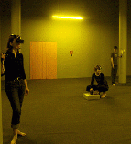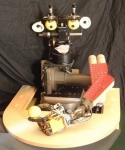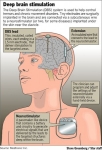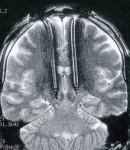May 02, 2006
Steady-state somatosensory evoked potentials
Steady-state somatosensory evoked potentials: suitable brain signals for brain-computer interfaces?
IEEE Trans Neural Syst Rehabil Eng. 2006 Mar;14(1):30-7
Authors: Müller-Putz GR, Scherer R, Neuper C, Pfurtscheller G
One of the main issues in designing a brain-computer interface (BCI) is to find brain patterns, which could easily be detected. One of these pattern is the steady-state evoked potential (SSEP). SSEPs induced through the visual sense have already been used for brain-computer communication. In this work, a BCI system is introduced based on steady-state somatosensory evoked potentials (SSSEPs). Transducers have been used for the stimulation of both index fingers using tactile stimulation in the "resonance"-like frequency range of the somatosensory system. Four subjects participated in the experiments and were trained to modulate induced SSSEPs. Two of them learned to modify the patterns in order to set up a BCI with an accuracy of between 70% and 80%. Results presented in this work give evidence that it is possible to set up a BCI which is based on SSSEPs.
22:45 Posted in Brain-computer interface | Permalink | Comments (0) | Tags: Positive Technology
Does subliminal advertising work?
Via Kurzweilai.net
Researchers have shown that subliminal advertising may work after all..
New Scientist: It was a stunt that launched a thousand conspiracy theories. Market researcher James Vicary claimed in 1957 that he could get movie-goers to "drink Coca-Cola" and "eat popcorn" by flashing those messages on the screen for such a short time that viewers were unaware of it. People were outraged, and the practice was banned in the UK, Australia and the US.
Vicary later admitted that his study was fabricated, and scientists through the years who have tried to replicate it have largely failed. But now researchers have shown that if the conditions are right, subliminal advertising to promote a brand can be made to work.
Read the full article
22:40 Posted in Persuasive technology | Permalink | Comments (0) | Tags: Positive Technology
Playing pong with thought
22:37 Posted in Brain-computer interface | Permalink | Comments (0) | Tags: Positive Technology
Telepathy Playground
(Bill Hanley, Rhizome News)

Marseilles-based artist Mathieu Briand makes installations that use light, video, sound, and other media to let viewers destabilize and manipulate their own perceptions. His stylish works adopt the sleek, cold, and ambiguously menacing look of '2001: A Space Odyssey' and other dystopian science fiction fables of that era. Briand's first U.S. solo show recently opened at Los Angeles' Redcat gallery, and its title, Ubiq: A Mental Odyssey references both the Kubrick film and 'Ubik,' the Philip K. Dick classic about telepathy, unstable realities, and an elusive cure-all product. On view through June 18, the exhibition includes a standout work consisting of four retro-futuristic helmets outfitted with cameras and monitors, which allow wearers to swap perspectives and steal each other's points of view as they explore the exhibition. The piece highlights an important difference between Briand's work and the bleak science fiction tradition that he references: his work makes a hallucinatory future of failed technological utopias seem like fun. In these playful installations, a Phillip K. Dick-style confusion between reality and fractured perceptions becomes the perfect context for anarchic play. -
22:23 Posted in Cyberart | Permalink | Comments (0) | Tags: Positive Technology
BabyBot
From the BabyBot project website:

The Babybot is the LIRA-Lab humanoid robot. The latest version has eighteen degrees of freedom distributed along the head, arm, torso, and hand. The head and hand were custom designed at the lab. The arm is an off-the-shelf small PUMA manipulator and it is mounted on a rotating torso. The Babybot's sensory system is composed of a pair of cameras with space-variant resolution, two microphones each mounted inside an external ear, a set of three gyroscopes mimicking the human vestibular system, positional encoders at each joint, a torque/forse sensor at the wrist and tactile sensors at the fingertips and the palm.
The one you see in the picture above is the latest realization of the Babybot, a project started in 1996 at LIRA-Lab. The hardware itself went through many revisions so there's not much remaining of the mechanics of the first Babybot beside the PUMA arm.
Our scientific goal is that of uncovering the mechanisms of the functioning of the brain by building physical models of the neural control and cognitive structures. In our intendment physical model are embodied artificial systems that freely interact in a not too unconstrained environment. Also, our approach derives from studies of human sensorimotor and cognitive development with the aim of investigating if a developmental approach to building intelligent systems may offer new insight on aspects of human behavior and new tools for the implementation of complex, artificial systems.
Examples of the behaviors we implemented include (but not only) the control of eye movements such as vergence, saccades, and vestibulo-ocular reflex. We've been working on the integration of different sensory modalities as for example vestibular and visual cues, or acoustic perception with vision. We implemented reaching behavior as a means to physically interact with the external environment to discover about the properties of objects.
22:09 Posted in AI & robotics | Permalink | Comments (0) | Tags: Positive Technology
Computer game technology will plug directly into our brains
Via the Presence Mailing List
(from Australia's The Age)
The new PlayStation or X-box may not need a joystick, with the Federal Government approving the development of Australian computer game technology that plugs directly into our brains.
With technology that is reminiscent of science fiction classics such as Ghost in the Shell, Lawnmower Man and Firefox, Sydney-based company Emotiv Systems will develop, with the assistance of $1.5 million in Federal Government funding, a wireless headset that will "read" brain waves for a gaming experience that will blur the line between fantasy and reality.
The funding was announced by federal Industry Minister Ian Macfarlane yesterday, and forms part of the Government's Commercial Ready program, the aim of which is to help develop new Australian ideas into commercially viable products.
Read the full story
14:25 Posted in Brain-computer interface | Permalink | Comments (0) | Tags: Positive Technology
May 01, 2006
PsychNology Journal - Call for Papers

PsychNology Journal will host three special issues on the following themes:
- "Designing technology to meet the needs of the older user", edited by Eva Lindh Waterworth and John Waterworth
- "Mobile media and communication – reconfiguring human experience and social practices?", edited by Ilkka Arminen
- "Emerging trends in Cybertherapy", edited by Giuseppe Riva and Brenda K. Wiederhold
12:26 Posted in Call for papers | Permalink | Comments (0) | Tags: Positive Technology
ENKI
Via WMMNA
In the field of psychology, it has long been known that brain wave activity of persons subjected to a light flashing at a certain frequency would fall in sync with the flashing of the lights. Drawing on this observation, several devices have been developed to entrain brain waves. These systems are used by psychologists in their practices and by the general public for relaxation, stress management, insomnia, accelerated learning and retention, phobias, anxiety, fun, etc.

It uses sound and light pulses - to induce a state of 'extreme relaxation' similar to the way traditional Sound and Light Entrainment devices (SLEDs) work - the difference is that ENKI uses the electric communication signals from Electric Fish rather than a pre-programmed chip. Ultimately ENKI offers the possibility of becoming one with the mind of 'nature' - and by default, achieving an altered, beneficial state through this experience.

The ENKI prototype has been developed through research into interactive biotechnological systems, biophysics, as well as other, believed scientific theories and ideas, used to develop similar technologies in the realm of medicine, neuroscience and other more obscure healing technologies.

A list of movies documenting the project can be found here
11:55 Posted in Neurotechnology & neuroinformatics | Permalink | Comments (0) | Tags: Positive Technology
Interactive Media Studies Tenure-Track Positions, National University of Singapore
In view of government and industry interest to develop Singapore as an interactive media hub, the National University of Singapore seeks to expand its research and teaching expertise in the area. The Communications and New Media (CNM) Programme in the Faculty of Arts and Social Sciences invites applications for five tenure-track positions at either Assistant or Associate Professor levels.
We are seeking media scholars (Ph.D. /M.F.A. preferred) who conduct research, do creative work and/or have industry experience in one or more of the following areas:
1. Interactive Media content design and development—including games/interactive entertainment/serious games/e-learning, virtual/immersive environments, visual interface design, information architecture, interaction design, mobile and web-based content, e-learning
2. HCI and evaluation research—including observational research, mobile and pervasive computing, usability, presence & VR, social computing (virtual collaboration, social software and social networks), parasocial relationships
3. User experience design/strategy and innovation—including understanding the impact, desirability and context of interactive media technology from the perspectives of sociology, anthropology, psychology, ethnography, ergonomics/human factors
4. Interactive advertising/business/marketing—including electronic customer relationship management, interactive campaigns, mobile advertising
5. Media arts—storytelling, cyberculture and cyberarts, new media arts (theory and practice)
The successful applicant will teach core CNM courses as well as courses in his/her area of specialization. Examples of courses offered by our programme include Aesthetics of New Media, Critical Introduction to Gaming, Visual Design and Game Design. New courses include User Experience Design, Interactive Storytelling, and Interactivity and Everyday Life. For more details please see http://www.fas.nus.edu.sg/cnm
Preference will be given to candidates who show evidence of (1) completing their Ph.D. by May 2006 (ABDs may apply); (2) effective teaching; (3) research/creative productivity; and (4) experience or promise in obtaining external grant funding.
Review of applications will commence immediately and chosen applicants will be able to start in August 2006 or January 2007. The search will continue until all the positions are filled.
Send
(1) letter of application (addressing teaching/ research/creative interests and teaching effectiveness),
(2) C.V. and
(3) three letters of reference
to Dr. Sun Sun Lim at cnmjob@nus.edu.sg, or fax (65) 6779-4911.
-----------------------------------
To find out more about living and working in Singapore, see http://www.contactsingapore.org.sg/
To find out more about the National University of Singapore, see http://www.nus.edu.sg In the recent Times Higher Education Supplement World University Rankings, NUS was ranked 22nd in the world and amongst the top three universities in Asia.
11:39 Posted in Research institutions & funding opportunities | Permalink | Comments (0) | Tags: Positive Technology
Ethicbots Workshop
International Workshop
Naples , 17-18 October, 2006
This workshop aims at exploring the techno-ethics of human interactions with adaptive and cognitive systems developed in the framework of Robotics, Bionics, and Artificial Intelligence. These interactions notably include:
• human-robot non-invasive interactions, involving autonomous robots which inhabit human environments;
• human-machine invasive interactions, involving bionic systems for restoring or enhancing human functionalities;
• human-softbot interactions, involving AI systems for information access and communication.
Critical ethical issues arising in these domains concern
• preservation and promotion of human freedom, rights, and identity;
• fair access to adaptive machinery resources;
• scientific method and techno-ethical policies;
• precautionary principles in human-machine interactions;
• responsibilities for cooperative human-machine deliberation and action;
• machine autonomy and accountability;
• individual and societal impact of human-machine cognitive and affective bonds;
• intercultural aspects of robot development, design, and use.
The joint effort of researchers in various areas of inquiry - including robotics, bionics, the cognitive (neuro-)sciences, artificial intelligence, anthropology, philosophy, and law - is needed to identify and analyze techno-ethical issues concerning the interaction of human beings with adaptive and cognitive machines. This workshop aims at providing a multidisciplinary forum for discussing these techno-ethical issues and understanding their import on the proper implementation of ethical monitoring, triaging, warning, and institutional opinion generation.
The workshop is supported by the ETHICBOTS European Project (http://ethicbots.na.infn.it).
Scientific Board (to be completed): Daniela Cerqui (Switzerland), Paolo Dario (Italy), Rüdiger Dillmann (Germany), Armin Grunwald (Germany), Alan Mackworth (Canada), Abbe Mowshowitz (USA) Brian O'Connell (USA), Richard Rosenberg (Canada), Jutta Weber (Austria).
Organizing committee: Rafael Capurro (Hochschule der Medien, Stuttgart, GER), Raja Chatila (LAAS-CNRS, Toulouse, FR), Thomas Christaller (Fraunhofer Institut-AIS, Sankt Augustin, GER), Adriano Fabris (Università di Pisa, IT), Satinder Gill (Middlesex University, London, UK), Alessandro Giordani (Facoltà di Teologia, Lugano, CH), Cecilia Laschi (Scuola Superiore S. Anna, Pisa, IT), Guglielmo Tamburrini (Università Federico II, Napoli, IT), Gianmarco Veruggio (Scuola di Robotica, Genova, IT), Kevin Warwick (Dept. of Cybernetics, University of Reading, UK)
Important dates:
Extended abstract (max 4 pages) : Submission by June 15, 2006
Venue : Centro Congressi Università di Napoli Federico II, Via Partenope 36, 80121 Napoli, Italy http://www.centrocongressi.unina.it/lungomare/lungomare.h...
Fees: 75 euros. Free admission for students.
11:32 Posted in Call for papers | Permalink | Comments (0) | Tags: Positive Technology
Free Network Visible Network

Free Network Visible Network is a project that combines different tools and processes to visualize, floating in the space, the interchanged information between users of a network. The people are able to experience in a new exciting way about how colorful virtual objects, representing the digital data, are flying around. These virtual objects will change their shape, size and color in relation with the different characteristics of the information that is circulating in the network.

11:20 Posted in Augmented/mixed reality | Permalink | Comments (0) | Tags: Positive Technology
Deep brain stimulation (DBS): the Next Revolution in Depression Treatment?
Researchers from the Cleveland Clinic and Brown University’s Butler Hospital have conducted anl experiment to assess the potential of deep brain stimulation (DBS) for the treatment of Major Depression, the most severe category of depression. In a MD, more of the symptoms of depression are present, and they are usually more intense or severe.

Participants underwent standardized and detailed psychiatric, quality-of-life, and neuropsychological assessments on a regularly scheduled basis, both pre- and postsurgically. At a minimum of six months postsurgery, four of the six patients showed a clinically significant reduction in depression severity of 50 percent or greater on the Montgomery-Asberg Depression Rating Scale. Quality-of-life measures improved as well, and patients showed progressive improvements in mood and functioning over time. One patient experienced persistent occipital pain that was alleviated with repositioning of a subcutaneous connector wire.

Larger-scale clinical trials are needed to demonstrate the effectiveness (or lack thereof) of the DBS treatment for depression.
11:00 Posted in Neurotechnology & neuroinformatics | Permalink | Comments (0) | Tags: Positive Technology
"Shrug-detecting" software recognizes your disinterest
Via Engadget
A team of computer vision researchers at the University of Illinois has developed "Shrug-detecting" technology that recognizes the level of confusion or disinterest. The system works by allowing a webcam-equipped computer to pick up on the "relative fast movement of the shoulder toward the face". Researchers hope that the Shrug-detector will soon be complemented with real-time blink, hand-motion and facial expression detectors.
 More technical information about the Shrug-detector can be found in this paper (PDF).
More technical information about the Shrug-detector can be found in this paper (PDF).
10:38 Posted in AI & robotics | Permalink | Comments (0) | Tags: Positive Technology









 Via
Via